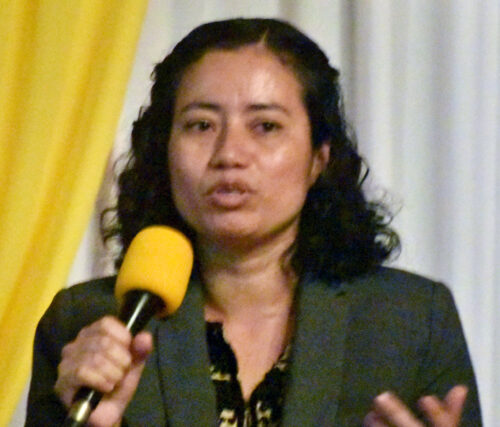S.H.A.K.E. the salt habit campaign – MoHW Community Health Workers at training seminar
by William Ysaguirre (Freelance Writer)
OLB BELIZE MUSEUM, Belize City, Fri. May 23, 2025
The excessive consumption of salt can cause hypertension and heart disease, the leading cause of death in Belize, which is why the Ministry of Health and Wellness (MoHW) is encouraging all Belizeans to kick the salt habit, to eat less salty foods, to consume as little salt as possible. The Health ministry launched its “SHAKE the Salt habit” campaign with an educational video at a training seminar for community health workers at the Old Belize Pavilion at Cucumber Beach last Friday morning, May 23. The program is backed by WHO/PAHO, in partnership with the International Cooperation Development Fund (ICDF) of the Republic of China on Taiwan.

Nutritionist Floridalma Fajardo Vairez
SHAKE is a program endorsed by the World Health Organization (WHO) which published a SHAKE technical package in 2018, explained nutritionist Floridalma Fajardo Vairez of the Southern Health region. The SHAKE technical package from WHO outlines 5 interventions: Surveillance – to measure and monitor salt intake. 2. Harness – the food industry to reformulate food products and meals with less salt. 3. Adopt – standards for food labelling to warn consumers of high salt content. 4. Knowledge – to empower the people to decide for themselves to avoid too much salt. 5. Environment – where all those around you, the food on sale in the stores, everywhere support and encourage healthy eating.

Nutritionist Robyn Daly
The numbers are indisputable, as nutritionist Robyn Daly of MoHW explained. Of the 2,303 deaths recorded in 2023, 365 were from heart disease, 323 from cancer, 167 from unintentional injuries, 152 from diabetes, and 124 from cerebro-vascular disease. Last year 2,229 deaths were recorded, of which 330 or 14.8 percent were from heart disease. Malignant neoplasms (cancer) claimed 251 lives or 11.26 percent of the deaths. Diabetes mellitus took away 186 lives, or 8.34 percent of the deaths. Cerebro-vascular disease claimed 98 lives – 4.40 percent of deaths. Chronic liver disease and cirrhosis took 78 more lives, or 3.50 percent deaths; and essential hypertension and renal diseases accounted for 66 deaths or 2.96 percent. By comparison, influenza and pneumonia took 108 lives – 4.85 percent, and there were 103 murders – 4.62 percent of the death roll. In our big family of 410,917 inhabitants, 35 percent of the deaths were caused by Non-Communicable Diseases (NCDs).

John Bodden – Principal Health Inspector
Some risk factors are unavoidable: our age, sex, family history, ethnicity and a previous history of stroke or heart attack; but we can change the way we live and eat to reduce our other risk factors. These risk factors include an unhealthy diet, lack of exercise, high blood sugar levels, smoking, excessive alcohol consumption, overweight, stress, high blood pressure, and high cholesterol levels. Daly recommended a balanced diet of fruits, vegetables, whole grains high in fiber, and lean meats and low-fat dairy products; to favor poly unsaturated fats and monounsaturated fats such as found in avocados and olive oil; and to stay away from saturated fats, as in animal fats which can raise cholesterol levels. Simply put: eat less salt, sugar and fats.
The Pan American Health Organization (PAHO) has advocated that countries pass laws requiring manufacturers and food processors to put warning signs in bold octagonal STOP signs on the front of their labels and packaging, to indicate when a food product is high in salt, sugar and fat. Many countries in the region have adopted these laws, notwithstanding manufacturers’ objections. Ideally, you want to reduce your daily salt intake to less than 5 grams or one teaspoonful, and most people unwittingly eat double the recommended dose of salt. To eat less salt, one can avoid processed and canned foods and meats, like ham, bacon and sausages, and this means smart shopping – read the label for the table of contents and ingredients before you buy.

Nutritionist Kathleen Cho
The ministry is rolling out this education campaign to the community through its community health workers, who will begin free health checks at health fairs to check for blood pressure, glucose level, and to measure body mass index to warn those who are overweight or obese, Mrs. Kathleeen Cho indicated. So far, they have organized 37 screening sessions, in which 1,682 people participated and 1,458 were screened voluntarily, which led to 105 being referred for further follow-up health care. The community workers are also reaching out to help people enjoy the fun of becoming more active through dance, yoga and workout sessions; there is strength in numbers and participants give moral support to each other to keep on moving and grooving. The community health workers are also charged with monitoring their charges’ performance, improvement and recidivism, to go after their “lost sheep”.
The long-term goal is to enlist food manufacturers’ cooperation to reformulate their processed food to reduce sugar and salt content, and to place warning labels on their products which contain high levels of sugars, salts and fats. The general public can also learn to flavor their food with more herbs and spices and less salt. This public education will need to start in schools, of course, at as early an age as is possible. It’s easier to teach children to eat a low sodium diet from the get-go, than to teach adults to alter their eating habits.

